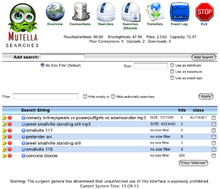List of historical Gnutella clients
Many projects have attempted to use the Gnutella network, since its introduction in early 2000. This list enumerates abandoned or discontinued projects.
List of discontinued clients
| Name | Platform | Last Release | License |
|---|---|---|---|
| Gnotella | Windows | before March 2002 [1] | FreeWare |
| Mactella | Macintosh | December 7, 2001 [2] | FreeWare |
| MLDonkey | Cross-platform | July 27, 2007 [3] | GNU GPL |
| Mutella | Unix | August 26, 2004 [4] | GPL |
| Newtella | Windows | December 18, 2000 [5] | FreeWare |
| PEERanha | Windows | April 12, 2002 [6] | Unknown |
| Qtella | Unix-like | May 27, 2004 [7] | GNU GPL |
| SwapNut | Windows | Unknown | Unknown |
| Swapper | Windows | Temporary due to litigation | Proprietary |
| ToadNode | Windows | October 1, 2002 [8] | Freeware |
| XoloX | Windows | April 21, 2003 [9] | Proprietary |
| XNap | Java | July 14, 2004 [10] | GNU GPL |
List of former gnutella clients
Software that still work but dropped the GNUtella protocol.
| Name | Platform | Last Release | License |
|---|---|---|---|
| FrostWire (since version 5 uses only BitTorrents) | Java | 6 (2015-02-18) | GNU GPL |
| MP3 Rocket (since 2011 is only a YouTube downloader) | Java | 7.3 (2015-03-02) | GNU GPL |
| iMesh (since version 6 dropped GNUtella) | Windows | 2012 | Proprietary |
Additional information
Mutella

- Developers - Max Zaitsev, Gregory Block
- Operating system - UNIX
- Latest release version - 0.4.5
- Genre - peer to peer
- License - gpl
- Website - Mutella development site
Mutella was a Gnutella client developed by Max Zaitsev and Gregory Block. It had two user interfaces, one for textmode use and another called remote control, which ran on an integrated web server and was used by a web browser. The first public version of Mutella was published on October 6, 2001.
The Mutella logo was changed into a squid somewhere around version 4.1. Before this change the logo used to be an Ouroboros. There was a blue and a black version of the ouroboros logo.
SwapNut
Slashdot reports that LimeWire and SwapNut used the same code. The website was www.swapnut.com.
XoloX
XoloX /ˈzoʊlɒks/ was a Gnutella-based peer-to-peer file sharing application for Windows. It advertised having no spyware, adware, or hijackware. However, upon installation, it prompted the user to install programs suspected to be of that kind. Also, Microsoft Anti-Spyware detected adware programs when you started to install the program.
XoloX links
- www.xolox.nl was the Official Website. Dead since June 2007.
- Review: Xolox
See also
References
- ↑ Gnotella discontinued post
- ↑ Tucows, Mactella Version 1.4.0
- ↑ MLDonkey removes Gnutella and G2 support.
- ↑ Mutella CHANGES files on Sourceforge.net
- ↑ Tucows, Newtella Version 1.0b3
- ↑ PEERanha developer signals the end.
- ↑ Qtella SourceForge.net page
- ↑ Free Download Center, Toadnode 3.1.3
- ↑ XoloX version 1.5 release
- ↑ Xnap SourceForge.net page
| ||||||||||||||||||